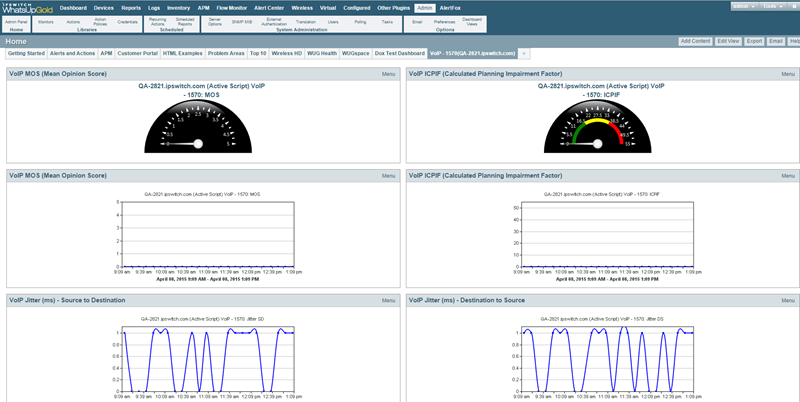VoIP Performance Monitor Reports
VoIP performance monitor data is available by selecting any VoIP dashboard view in the web interface created when configuring the VoIP monitor in the admin console.

The VoIP dashboard reports available in the VoIP dashboard view are:
MOS (Mean Opinion Score). This numerical data indicates the perceived quality of received voice media after it has been compressed and transmitted from a source to a destination device. The MOS rating is based on the following scale:
MOS |
Quality |
Description of quality impairment |
5 |
Excellent |
Imperceptible |
4 |
Good |
Perceptible, but not annoying |
3 |
Fair |
Slightly annoying |
2 |
Poor |
Annoying |
1 |
Bad |
Very annoying |
Note: The MOS calculation performed by the Cisco IP SLA device can be customized to fit your network quality criteria using the advantage-factor command and other threshold criteria. For more information about this and other custom settings, see the Cisco document IP SLAs--Analyzing VoIP Service Levels Using the UDP Jitter Operation.
ICPIF (Calculated Planning Impairment Factor). This numerical data indicates a value for predefined combinations of packet loss and delay in VoIP communications transmitted from a source to a destination device.
Upper Limit for ICPIF |
Speech communication quality |
5 |
Very good |
10 |
Good |
20 |
Adequate |
30 |
Limiting case |
45 |
Exceptional limiting case |
55 |
Customers likely to react strongly (complaints, change of network operator) |
Jitter - Source to Destination (ms). This data indicates the interpacket delay variance (difference between the interpacket arrival and departure) from the source to the destination devices. Jitter measures the variation in network latency that results in a loss of synchronization over time. It is noticeable to users as distracting pops, clicks, and other line noise.
Jitter - Destination to Source (ms). This data indicates the interpacket delay variance (difference between the interpacket arrival and departure) from the destination to the source devices. Jitter measures the variation in network latency that results in a loss of synchronization over time. It is noticeable to users as distracting pops, clicks, and other line noise.
Latency - Source to Destination (ms). This data indicates the delay between the time the source device begins sending voice data and the time the destination device begins receiving the voice data. It is noticeable to users as the time difference between when a caller speaks and when the other caller hears what the caller said. If these conversation gaps are large enough, callers may find that they inadvertently interrupt each other in conversations.
Latency - Destination to Source (ms). This data indicates the delay between the time the destination device begins sending voice data and the time the source device begins receiving the voice data. It is noticeable to users as the time difference between when a caller speaks and when the other caller hears what the caller said. If these conversation gaps are large enough, callers may find that they inadvertently interrupt each other in conversations.
Percent Packet Loss - Source to Destination. This data indicates the percentage of lost voice data packets between the source and destination devices.
Percent Packet Loss - Destination to Source. This data indicates the percentage of lost voice data packets between the destination and source devices.